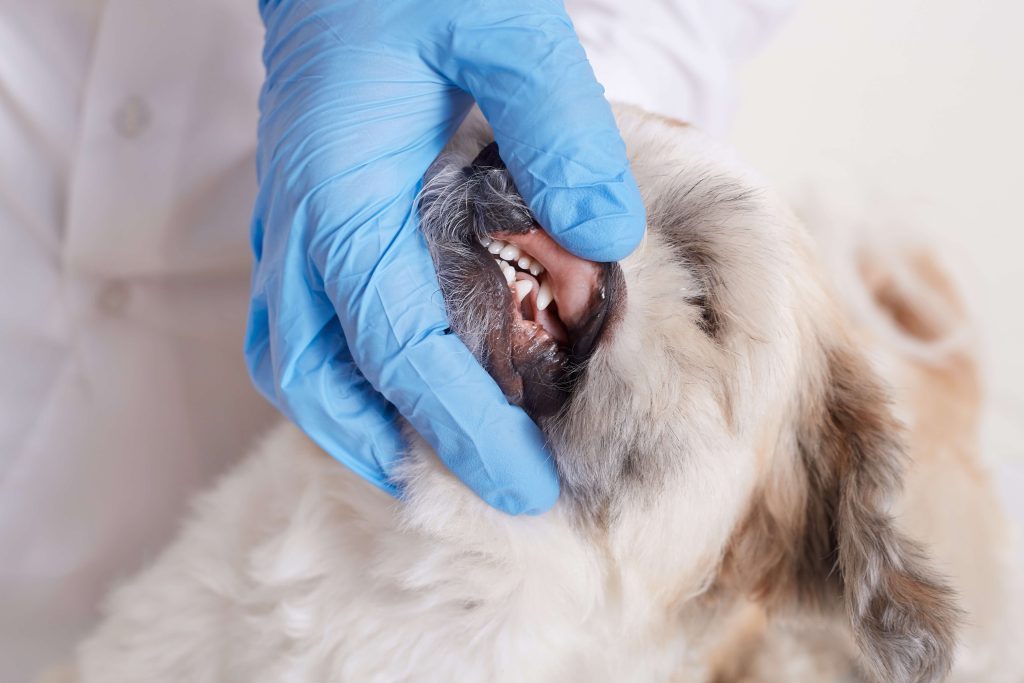- +91 6235806114
- +91 6235806115
- 24 X 7 Casualty
- 8.00 am – 9.00 pm
Pet Dental Care And Treatment in Cochin
Do you know that with good dental care, your pets can have a 20 % longer life?
Pet Dental Care Treatments That We Offer

An oral dental evaluation can be done with and without anesthesia. First, we perform a regular exam without anesthesia to look for obvious dental problems. In an oral dental exam performed under general anesthesia, we use radiographs to find problems below the gum line. We identify broken teeth or roots, dead teeth, periodontal disease, and infected teeth. We have a veterinary anesthesiologist to oversee all the procedures. You can take your pet to a routine dental checkup or when you notice any sign of pain or changes in eating behavior.
Regular dental cleaning has to be done to prevent tartar or plaque build-up in the mouth. Most owners skip this because pets do not sit still. You can bring your pet to us to get them cleaned regularly. Our veterinarian will give a dental exam first to identify any problems. Then, we will give a full cleaning under the gum line where bacteria that cause periodontal diseases live. Then, we do scaling and polishing of the crown which is the visible part of your pet’s teeth. Scaling involves scraping off the plaque and tartar build-up in the mouth using ultrasonic scalers. Finally, we polish the teeth and make necessary recommendations. We can also seal the teeth if required to keep them clean longer.
Periodontal diseases occur in around 85 percent of dogs after 4 years and it is also common in cats. The gum tissue and the periodontal ligaments can be affected by plaque build-up and harmful bacteria. The infection in the mouth can even spread to other parts of the body. We use intra-oral radiographs or X-rays to detect the problems. There are four stages of periodontal disease. We determine the stage of the disease and take the necessary measures which may range from regular cleaning(dental prophies) to advanced periodontal surgery and extractions.
Sometimes you need to extract a tooth if it is broken, a baby tooth is retained or the inner part called the pulp is exposed. Mostly, this can be an easy procedure done with a dental cleaning. But in some cases, you might need a surgical procedure if extraction is difficult. We have all the facilities for surgically removing any tooth that is a cause for pain and discomfort in pets.
A broken tooth can be the source of pain and infection in pets. This can even lead to severe conditions like a broken jaw. Removing important teeth like canines and carnassials can be traumatic for pets and they might need further treatment even after the extraction. Root Canal Therapy or endodontics is a better alternative here as a freshly broken tooth can be capped within two days.
We use tooth restoratives or fillings on teeth in case of problems such as enamel abnormalities, tooth damage that has not exposed the pulp, and exposure to dentine which causes dental sensitivity. By placing restorations, you can ensure oral hygiene and lower the risk of infections and periodontal disease
There are many cases in which your pets have teeth that do not fit together or malocclusion. This can be due to genetics or disease and can cause many problems in pets. At Pet Trust hospital, our veterinarians will help your pets relieve the pain and problems of teeth positions by using orthodontic buttons, elastics, crown extensions, and other orthodontic appliances.
The chances of tumors developing in pets are high. This can affect the jaws and you might need surgery to remove benign and malignant tumors. We have a fully equipped ICU and facilities, a veterinarian oncologist who can help in treating your beloved pet.
We fix and repair fractured jaws using non-invasive methods such as specialized dental materials as a splint to allow healing without surgery.
How To Spot Dental Problems In Your Pet?
1. Bad Breath
This is one of the most common in pets. A lot of pet owners assume that bad breath is common for pets. In most cases, bacteria can be the cause of bad breath. But, bad breath in pets can also be a sign of liver or kidney problems. Pet’s mouths are similar to ours in terms of dental health and should be properly taken care of.
2. Gum Problems
Swollen, red, or bleeding gums are obvious signs of oral problems, and early signs of oral disease you need to take appropriate actions for.
3. Discomfort When Eating
If your pet shows any signs of discomfort while chewing, shows any reluctance to eat, swallow food as a whole, then take them for a check-up.
4. Excessive Drooling
Drooling can be caused by excessive tartar build-up. Take your pet to the vet and get a check-up in case of excessive drooling.
5. Losing Teeth or Discolored Teeth
If your pet is losing teeth, it can be a sign of severe periodontal disease. If the color of the teeth has changed, it might be due to an injury or abnormal formation of the tooth.
6. Swelling of Face
Swelling can be a sign of inflammation and infection in the mouth. Inflammation is the early sign of oral diseases.
Need Any Services Call Us On +91 6235806115


